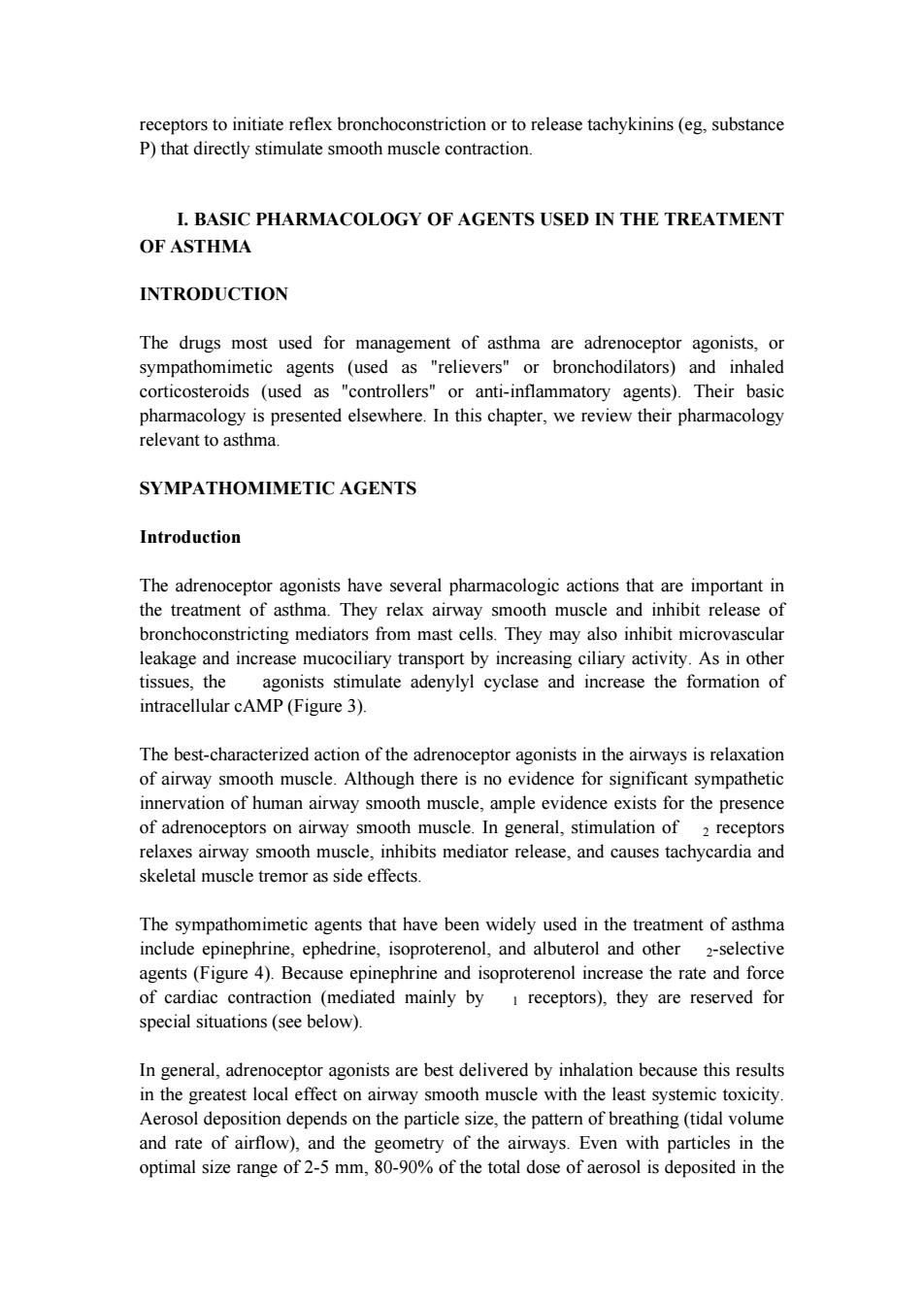正在加载图片...

receptors to initiate reflex bronchoconstriction or to release tachykinins(eg,substance P)that directly stimulate smooth muscle contraction. I.BASIC PHARMACOLOGY OF AGENTS USED IN THE TREATMENT OF ASTHMA INTRODUCTION The drugs most used for management of asthma are adrenoceptor agonists,or sympathomimetic agents (used as "relievers"or bronchodilators)and inhaled corticosteroids (used as "controllers"or anti-inflammatory agents).Their basic pharmacology is presented elsewhere.In this chapter,we review their pharmacology relevant to asthma. SYMPATHOMIMETIC AGENTS Introduction The adrenoceptor agonists have several pharmacologic actions that are important in the treatment of asthma.They relax airway smooth muscle and inhibit release of bronchoconstricting mediators from mast cells.They may also inhibit microvascular leakage and increase mucociliary transport by increasing ciliary activity.As in other tissues,the agonists stimulate adenylyl cyclase and increase the formation of intracellular cAMP(Figure 3) The best-characterized action of the adrenoceptor agonists in the airways is relaxation of airway smooth muscle.Although there is no evidence for significant sympathetic innervation of human airway smooth muscle,ample evidence exists for the presence of adrenoceptors on airway smooth muscle.In general,stimulation of 2 receptors relaxes airway smooth muscle,inhibits mediator release,and causes tachycardia and skeletal muscle tremor as side effects. The sympathomimetic agents that have been widely used in the treatment of asthma include epinephrine,ephedrine,isoproterenol,and albuterol and other 2-selective agents(Figure 4).Because epinephrine and isoproterenol increase the rate and force of cardiac contraction (mediated mainly by receptors),they are reserved for special situations(see below). In general,adrenoceptor agonists are best delivered by inhalation because this results in the greatest local effect on airway smooth muscle with the least systemic toxicity. Aerosol deposition depends on the particle size,the pattern of breathing(tidal volume and rate of airflow),and the geometry of the airways.Even with particles in the optimal size range of 2-5 mm,80-90%of the total dose of aerosol is deposited in thereceptors to initiate reflex bronchoconstriction or to release tachykinins (eg, substance P) that directly stimulate smooth muscle contraction. I. BASIC PHARMACOLOGY OF AGENTS USED IN THE TREATMENT OF ASTHMA INTRODUCTION The drugs most used for management of asthma are adrenoceptor agonists, or sympathomimetic agents (used as "relievers" or bronchodilators) and inhaled corticosteroids (used as "controllers" or anti-inflammatory agents). Their basic pharmacology is presented elsewhere. In this chapter, we review their pharmacology relevant to asthma. SYMPATHOMIMETIC AGENTS Introduction The adrenoceptor agonists have several pharmacologic actions that are important in the treatment of asthma. They relax airway smooth muscle and inhibit release of bronchoconstricting mediators from mast cells. They may also inhibit microvascular leakage and increase mucociliary transport by increasing ciliary activity. As in other tissues, the agonists stimulate adenylyl cyclase and increase the formation of intracellular cAMP (Figure 3). The best-characterized action of the adrenoceptor agonists in the airways is relaxation of airway smooth muscle. Although there is no evidence for significant sympathetic innervation of human airway smooth muscle, ample evidence exists for the presence of adrenoceptors on airway smooth muscle. In general, stimulation of 2 receptors relaxes airway smooth muscle, inhibits mediator release, and causes tachycardia and skeletal muscle tremor as side effects. The sympathomimetic agents that have been widely used in the treatment of asthma include epinephrine, ephedrine, isoproterenol, and albuterol and other 2-selective agents (Figure 4). Because epinephrine and isoproterenol increase the rate and force of cardiac contraction (mediated mainly by 1 receptors), they are reserved for special situations (see below). In general, adrenoceptor agonists are best delivered by inhalation because this results in the greatest local effect on airway smooth muscle with the least systemic toxicity. Aerosol deposition depends on the particle size, the pattern of breathing (tidal volume and rate of airflow), and the geometry of the airways. Even with particles in the optimal size range of 2-5 mm, 80-90% of the total dose of aerosol is deposited in the